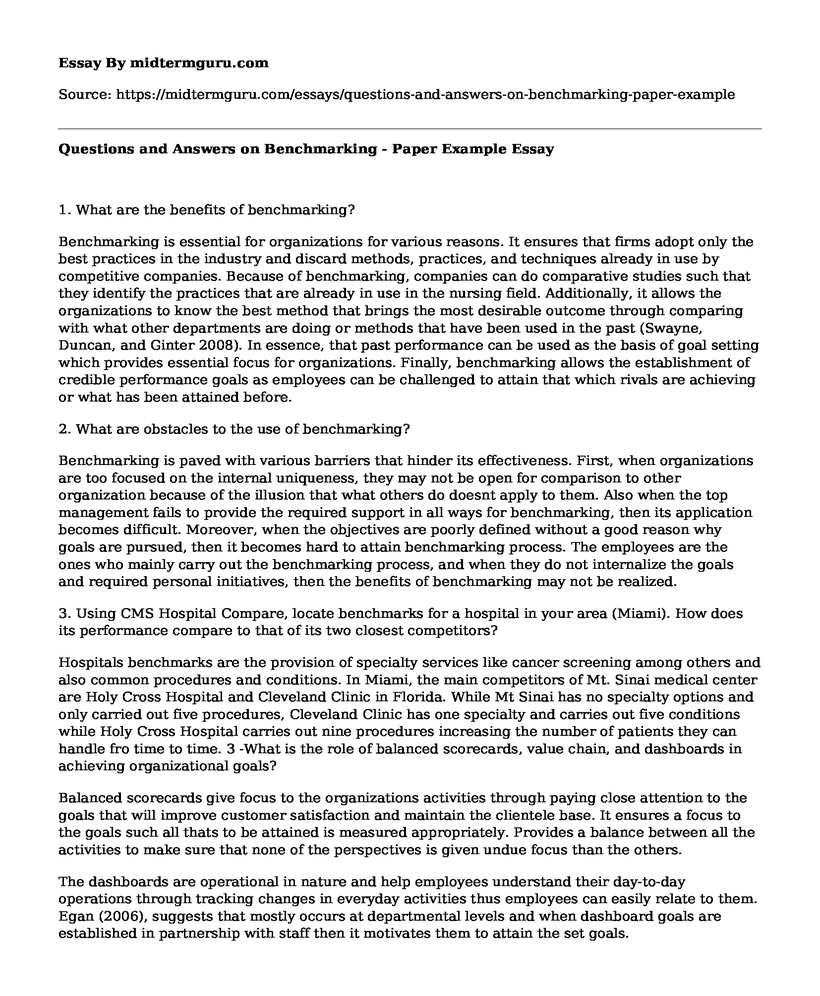1. What are the benefits of benchmarking?
Benchmarking is essential for organizations for various reasons. It ensures that firms adopt only the best practices in the industry and discard methods, practices, and techniques already in use by competitive companies. Because of benchmarking, companies can do comparative studies such that they identify the practices that are already in use in the nursing field. Additionally, it allows the organizations to know the best method that brings the most desirable outcome through comparing with what other departments are doing or methods that have been used in the past (Swayne, Duncan, and Ginter 2008). In essence, that past performance can be used as the basis of goal setting which provides essential focus for organizations. Finally, benchmarking allows the establishment of credible performance goals as employees can be challenged to attain that which rivals are achieving or what has been attained before.
2. What are obstacles to the use of benchmarking?
Benchmarking is paved with various barriers that hinder its effectiveness. First, when organizations are too focused on the internal uniqueness, they may not be open for comparison to other organization because of the illusion that what others do doesnt apply to them. Also when the top management fails to provide the required support in all ways for benchmarking, then its application becomes difficult. Moreover, when the objectives are poorly defined without a good reason why goals are pursued, then it becomes hard to attain benchmarking process. The employees are the ones who mainly carry out the benchmarking process, and when they do not internalize the goals and required personal initiatives, then the benefits of benchmarking may not be realized.
3. Using CMS Hospital Compare, locate benchmarks for a hospital in your area (Miami). How does its performance compare to that of its two closest competitors?
Hospitals benchmarks are the provision of specialty services like cancer screening among others and also common procedures and conditions. In Miami, the main competitors of Mt. Sinai medical center are Holy Cross Hospital and Cleveland Clinic in Florida. While Mt Sinai has no specialty options and only carried out five procedures, Cleveland Clinic has one specialty and carries out five conditions while Holy Cross Hospital carries out nine procedures increasing the number of patients they can handle fro time to time. 3 -What is the role of balanced scorecards, value chain, and dashboards in achieving organizational goals?
Balanced scorecards give focus to the organizations activities through paying close attention to the goals that will improve customer satisfaction and maintain the clientele base. It ensures a focus to the goals such all thats to be attained is measured appropriately. Provides a balance between all the activities to make sure that none of the perspectives is given undue focus than the others.
The dashboards are operational in nature and help employees understand their day-to-day operations through tracking changes in everyday activities thus employees can easily relate to them. Egan (2006), suggests that mostly occurs at departmental levels and when dashboard goals are established in partnership with staff then it motivates them to attain the set goals.
The health care value chain is essential as it helps gather the marketing mix in the pre-service stage which will be the basis of the goals set. The point of service step assists in the attaining of set goals through implementation. Finally, the after service acts a control to find out if goals were achieved. 5. Discuss the three phases of implementation.
Pre-implementation phase is the face phase that consists of setting important goals through appropriate research to gather information necessary information about what the needs of the clients are and the products that would meet those needs. The goals that are realistic, attainable, measurable time-bound are set against the required standard.
At point stage is where actual implementation occurs. The activities and operations necessary to attain the goals are carried out using the objectives as the basis and guidelines.
The post-implementation phase acts as a control mechanism where the actual goals are compared to the set goals and gaps identified are addressed. It involves evaluation and assessment of the performance. 6. What can managers do to encourage change?
Managers play a central role in promoting and implementing change. They communicate the need for change to the employees and using various strategies explain to the employees the threats of not undertaking the change. For instance, reduced clientele base which would affect their income. Managers can also use incentives which can be monetary or non-monetary to induce change. They should also be able to provide concurrent feedback and reinforcement to the employees as a way of communicating that their efforts were worthwhile.
References
Egan M, (2006). Clinical Dashboards: Impact on Workflow, Care Quality, and Patient Safety, Critical Care Nursing Quarterly 29 (4): 354361.
Swayne L, Duncan WJ, and Ginter P,. (2008). Strategic Management of Health Care Organizations, 6th ed., Jossey-Bass, San Francisco, CA.
Cite this page
Questions and Answers on Benchmarking - Paper Example. (2021, Jul 01). Retrieved from https://midtermguru.com/essays/questions-and-answers-on-benchmarking-paper-example
If you are the original author of this essay and no longer wish to have it published on the midtermguru.com website, please click below to request its removal:
- Product Comparison in Terms of Packaging Bottles Designs of Shaving Creams
- Ethical Theories of Healthcare Ethics and Law - Essay Example
- Assignment Example on Workplace Safety
- Paper Example on Human Motivation
- The American Nurse Association (ANA) and its Effectiveness - Essay Sample
- CPOE: Enhancing Patient Safety & Reducing Errors in Healthcare - Essay Sample
- Acadia Pharmaceutical: Maximizing Profit & Competitive Advantage Through Strategic Planning - Essay Sample







